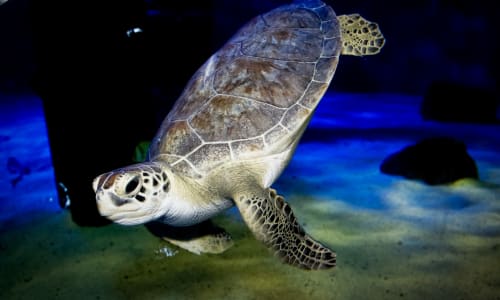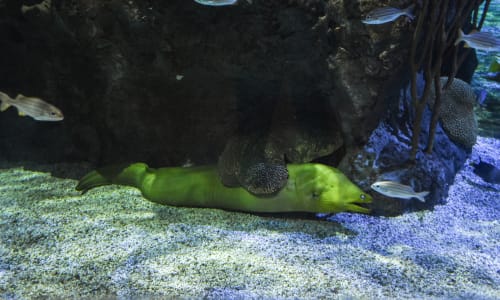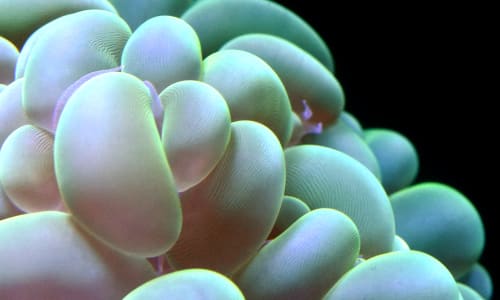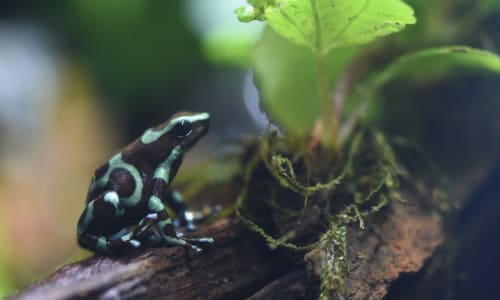
SEAing Green this St. Patrick’s Day!
March 17, 2023This St. Patrick's Day, we are highlighting the greenest animals that call Mystic Aquarium home! Although an aquarium might seem unconventional from the typical place to participate in this Irish holiday, Mystic Aquarium boasts an impressive array of green creatures, making it the perfect destination for celebration! In this blog post, we'll examine some of these fascinating animals and discover the unique traits and characteristics that make them special! From sea turtles to poison dart frogs, get ready to explore the diverse spectrum of green creatures that can be found at Mystic Aquarium this St. Patrick's Day and beyond!
Green Sea Turtle (Chelonia mydas)
Allow us to introduce you to Charlotte, the green sea turtle! Charlotte has been a beloved resident at Mystic Aquarium since his (yes, his!) arrival in 2008. Unfortunately, an injury left his rear flippers paralyzed and trapped air in his back end, resulting in a condition known as "bubble butt." Turtles with this syndrome often struggle with controlling their buoyancy, which is why Charlotte can frequently be seen swimming with his head down.
Green turtles are among the seven species of sea turtles, all of which are either threatened or endangered. As the largest hard-shelled sea turtles, green sea turtles are unique because they are herbivorous, feeding solely on green vegetation. Their plant-based diet not only gives them their name but also contributes to their distinctive green hue. The seagrass and algae they consume contain pigments that turn their fat greenish!

Green Moray Eel (Gymnothorax funebris)
Here's an interesting fact: the skin of the green moray eel is brown or gray, not green! So where does their distinctive green coloring come from? These eels secrete a yellowish mucus that protects them from parasites and bacteria, which, combined with their dark bodies, create the illusion of green. But that's not even the most peculiar thing about the green moray. They possess a second set of jaws! During feeding, the moray can launch these jaws into their mouths to seize prey and carry it into their throat.
Mystic Aquarium is proud to house a male green moray eel that has called our facility home since 2009. While he sometimes hides, guests may glimpse him lying on his side or even upside down. Although this behavior may seem odd, it is perfectly normal for this fascinating animal!

Green Bubble Coral (Plerogyra sinuosa)
Did you know some people believe green bubble coral brings good luck? While we can't verify that claim, its striking neon-green color certainly earns it a mention in this post. Green bubble coral is a type of large polyp stony coral commonly found in the Indo-Pacific region, particularly in the waters surrounding Australia, Indonesia, and the Philippines. The coral's numerous vesicles or sacs are filled with gas to help it float in the water column, giving it its unique bubble-like appearance. When cared for correctly, green bubble coral is considered a relatively hardy species that can thrive in a well-maintained reef aquarium.
In the wild, green bubble coral plays a critical role in the reef ecosystem by providing habitat and shelter for various marine organisms. Unfortunately, like many other coral species, it is threatened by human activities such as overfishing, pollution, and climate change, which can result in coral bleaching and death. At Mystic Aquarium, visitors can observe green bubble coral alongside other beautiful coral species in the coral reef habitat located in the Wild and Wonderful gallery.

Green Poison Dart Frog (Dendrobates auratus)
The green poison dart frog is a brightly colored and small frog species found in Central and South America, ranging from Nicaragua to Colombia. It is one of the most popular species of poison dart frog, both in the wild and in captivity. These frogs are typically 1 to 2 inches long, sporting bright green or turquoise bodies with black markings. They have smooth, moist skin and large, expressive eyes. Their striking coloration serves as a warning to predators that they are toxic and should not be eaten.
As with other poison dart frogs, the green poison dart frog produces toxins in its skin glands, which it uses as a defense mechanism. The toxins can cause paralysis, convulsions, and even death in predators that try to eat them. While poison dart frogs kept in aquariums generally don't produce poison like those in the wild, they are delicate creatures that should always be handled with care. The green poison dart frogs at Mystic Aquarium are housed in a habitat with other brightly colored dart frogs, including blue, yellow, and red, creating a rainbow of dart frogs for guests to enjoy.

Looking for even more green at the Aquarium? You're in luck! In the Main Gallery, you'll find a wide variety of green marine life, including emerald crabs, red-eyed tree frogs, and iridescent fish that shimmer with a rainbow of colors. And don't miss the pair of rare American lobsters—one blue and one yellow—that, when combined, make green! You may even spot a green bead on some of the ID bands on the wings of the African penguins, which helps trainers identify individual penguins.
If you're interested in learning more about Mystic Aquarium's efforts to protect endangered species like sea turtles, corals, and amphibians, be sure to click here!
Connect with us on social media and tell us which green animal at the Aquarium is your favorite. We're active on Facebook, Instagram, Twitter, LinkedIn, and YouTube!